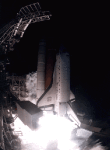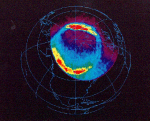
|
Astronomy Picture Of the Day (APOD)
 Impact! 65 Million Years Ago
Impact! 65 Million Years Ago
4.06.1996
What killed the dinosaurs? Their sudden disappearence 65 million years ago, along with about 70 percent of all species then living on Earth, is known as the K-T event (Cretaceous-Tertiary Mass Extinction event). Geologists and paleontologists often entertain the idea of a large asteroid or comet impacting the Earth as the culprit.
 Mir Dreams
Mir Dreams
3.06.1996
This dream-like image of Mir was recorded by astronauts as the Space Shuttle Atlantis approached the Russian Space Station prior to docking during the STS-76 mission. Sporting spindly appendages and solar pannels, Mir resembles a whimsical flying insect as it orbits above New Zealand's South Island near the Cook Straight.
 6 Up 5 Down
6 Up 5 Down
2.06.1996
This fish-eye view of a dramatic night launch of the Shuttle Atlantis on mission STS-76 was recorded on March 22, 1996. The mission carried 6 astronauts aloft, and returned with 5 -- delivering one crew member, Shannon Lucid, to the Mir Space Station. Lucid is currently onboard the Mir as a cosmonaut guest researcher.
 The Iron Moon
The Iron Moon
1.06.1996
In March and April of 1994 the unmanned Clementine spacecraft demonstrated the technique of prospecting on the Moon from lunar orbit. To accomplish this, Clementine turned an array of cameras sensitive to ultraviolet-visible and near-infrared light toward the lunar surface, producing the first broad-spectrum global imaging of the moon.
 The Pulsar Powered Crab
The Pulsar Powered Crab
31.05.1996
In the Summer of 1054 A.D. Chinese astronomers reported that a star in the constellation of Taurus suddenly became as bright as the full Moon. Fading slowly, it remained visible for over a year.
 Sunshine, Earthshine at the Lunar Limb
Sunshine, Earthshine at the Lunar Limb
30.05.1996
This dramatic image of the Moon's edge against a background of distant stars is from a perspective impossible for groundbased telescopes. It was taken by a star tracker camera onboard the Clementine spacecraft.
 The COMPTEL Gamma-Ray Sky
The COMPTEL Gamma-Ray Sky
29.05.1996
This premier gamma-ray view of the sky was produced by the COMPTEL instrument onboard NASA's orbiting Compton Gamma Ray Observatory. The entire sky is seen projected on a coordinate system centered on our Milky Way Galaxy with the plane of the Galaxy running across the middle of the picture.
 The Pipe Dark Nebula
The Pipe Dark Nebula
28.05.1996
The dark nebula predominant at the lower left of the above photograph is known as the Pipe Nebula. The dark clouds, suggestively shaped like smoke rising from a pipe, are caused by absorption of background starlight by dust.
 Aurora Crown the Earth
Aurora Crown the Earth
27.05.1996
What do aurora look like from space? The POLAR spacecraft answered this by photographing an auroral oval surrounding the north pole of the Earth, causing displays on both the night and day side. The auroral sub-storm, pictured in false-color above, developed within 15 minutes and may have lasted as long as on hour.
 Alpha Centauri: The Closest Star System
Alpha Centauri: The Closest Star System
26.05.1996
The closest star system to the Sun is the Alpha Centauri system. Of the three stars in the system, the dimmest -- called Proxima Centauri -- is actually the nearest star. The bright stars Alpha Centauri...
|
January February March April May June July August September October November December |
|||||||||||||||||||||||||||||||||||||||||||||||||